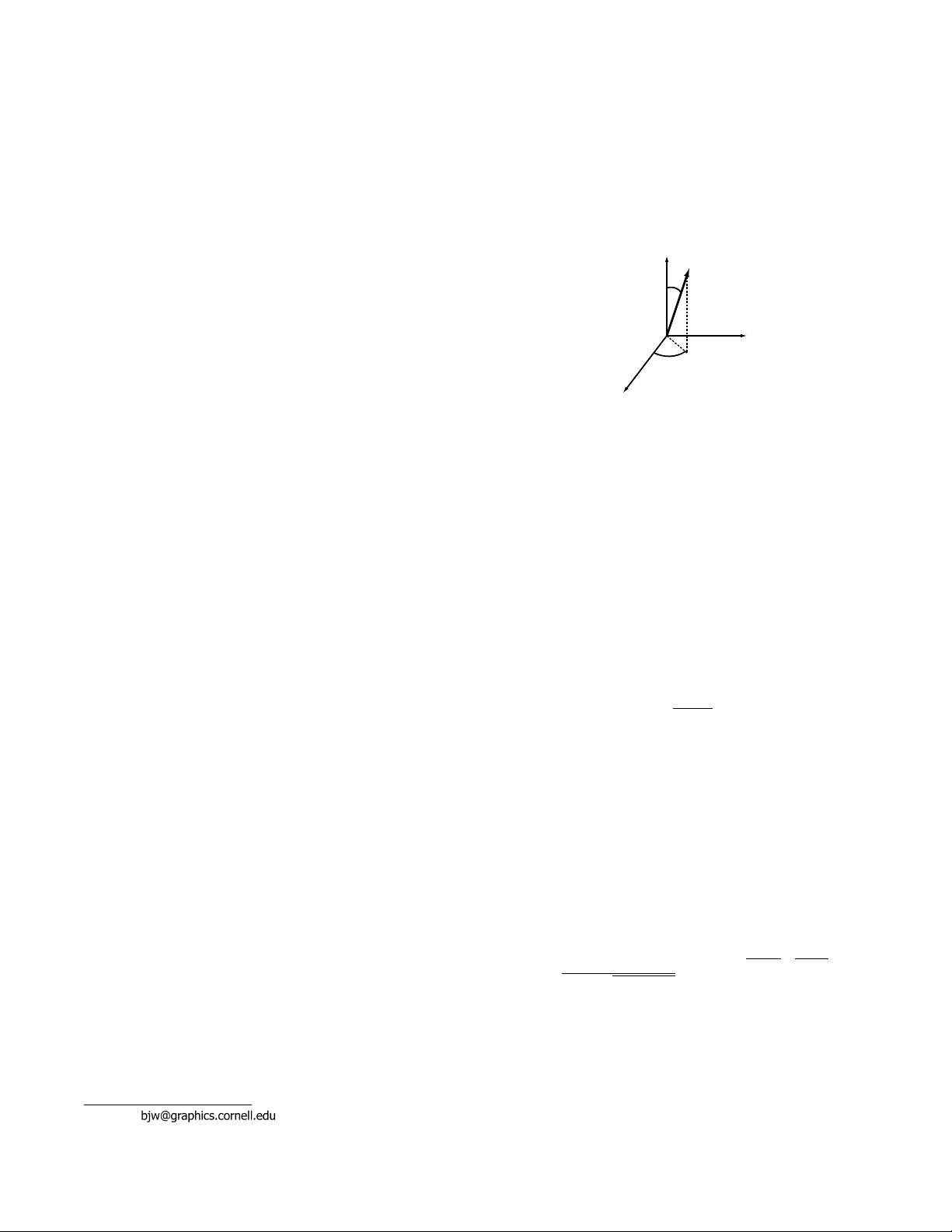
Notes on the Ward BRDF
Bruce Walter
∗
Technical Report PCG-05-06
Cornell Program of Computer Graphics
April 29, 2005
Abstract
The anisotropic BRDF introduced in [Ward 1992] has become
widely used in computer graphics, but some important implemen-
tation details are less widely known. We discuss how to efficiently
evaluate the Ward BRDF. Then we derive the probability density
function for its associated Monte Carlo sampling scheme and the
correct weights to use with the generated samples. Finally for the
isotropic version, we describe how to bound the maximum possible
BRDF value over a region of (direction) space.
1 Introduction
The Ward BRDF (Bidirectional Reflectance Distribution Function)
was introduced in [Ward 1992] as an empirical model to fit mea-
sured BRDF (i.e. surface reflectance) data. It has several advan-
tages over the prior BRDF models and has become widely used in
the computer graphics community. It uses only a few simple pa-
rameters making it easy to control, can be sampled efficiently for
Monte Carlo, can model anisotropic surfaces, and was shown to fit
reasonably well to measured BRDF data.
The purpose of this paper is to clarify and correct some important
implementation details of the Ward BRDF. We discuss how to effi-
ciently evaluate the BRDF in Section 2. Monte Carlo BRDF sam-
pling is required for many rendering algorithms, and hence, Ward
provided an efficient sampling scheme with his BRDF. However he
did not provide the associated probability density function, which
for mathematical accuracy, is needed to correctly weight the gen-
erated samples. We both discuss how to derive such probability
density functions in general in Section 3, and present the specific
results for the Ward BRDF in Equation 10.
Another powerful, though less widely used, BRDF operation is
the ability to bound its maximum value over a range of directions.
In Section 4, we discuss how to cheaply cheaply and tightly bound
the isotropic Ward BRDF over a set of directions defined by a spa-
tial bounding volume.
1.1 Notation
We will be working extensively with directions in 3D, which
we will denote in boldface (e.g., v). In actual use, these di-
rections are typically represented as normalized 3D vectors (e.g.,
v = [v
x
, v
y
, v
z
], where v
2
x
+v
2
y
+v
2
z
= 1). Directions can also be rep-
resented as two angles, θ and φ , using spherical polar coordinates
as illustrated in Figure 1. We will usually subscript these angles
with the direction that they are describing. We can convert between
the spherical angles and the 3D unit vector representations using:
(θ, φ ) ⇔
sinθ cos φ, sin θ sin φ , cos θ
(1)
The scalar dot product of two directions is equal to the cosine
of the angle between them (e.g., v ·z = cos θ
v
). When using 3D
vectors, the dot product can be computed by summing the products
of the corresponding components (e.g., u ·v = u
x
v
x
+ u
y
v
y
+ u
z
v
z
).
∗
email:
Figure 1: Spherical polar coordinates example. The direction v
can be fully described by two angles θ
v
and φ
v
. θ
v
is the angle
between v and the z-axis. φ
v
is the angle between the x-axis and v’s
projection onto the x-y plane.
A BRDF (Bidirectional Reflectance Distribution Function) de-
scribes how light is scattered at a surface. At a surface point it is a
function of two directions (an incident direction i and an outgoing
direction o) and written as f
r
(i,o). It is often convenient to con-
struct a coordinate frame on the surface where the z-axis is the same
of the local surface normal, n, and the x and y axes lie in the tangent
plane of the surface as shown in Figure 2. For anisotropic BRDFs,
the x and y axes must match the principle directions of anisotropy,
while they can be chosen arbitrarily for isotropic BRDFs.
The Ward BRDF uses the half direction h that is defined to be
halfway between the incident and out directions. It can be com-
puted by adding i and o as 3D vectors and then renormalizing:
h =
i + o
ki + ok
(2)
The half angle is motivated by microfacet BRDFs and produces
more realistic highlights than alternatives such as Phong (e.g., see
[Fisher 1994; Ngan et al. 2004]).
2 Ward BRDF
The original Ward BRDF is defined as the sum of two components
[Ward 1992, Equation 5a]. The first is a diffuse term, ρ
d
/π. Dif-
fuse components are relatively simple and already well understood,
so we will ignore the diffuse component for the remainder of this
paper. The second component is a gaussian anisotropic gloss lobe
defined by three parameters, ρ
s
, α
x
, and α
y
, as:
f
r
(i,o) =
ρ
s
4πα
x
α
y
√
cosθ
i
cosθ
o
e
−tan
2
θ
h
cos
2
φ
h
α
2
x
+
sin
2
φ
h
α
2
y
(3)
where ρ
s
controls the magnitude of the lobe, and α
x
and α
y
control
the width of the lobe in the two principal directions of anisotropy.
If α
x
= α
y
then the lobe is isotropic (i.e. invariant under surface
rotations around the surface normal).
Just after defining his BRDF, Ward presents an approximation
that is intended to be computationally cheaper [Ward 1992, Equa-
tion 5b]. There is no reason to ever use this approximation. The fol-
lowing vector equation is both exact and cheaper to compute than





































